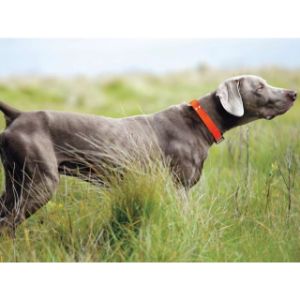Ear cropping is a common practice among many dog breeds, including the Weimaraner. This explains why you may have seen Weimaraner cropped ears here and there. However, it is a controversial topic.
Ear cropping has been done for a long time. There have been many proposed reasons for it, but all of them are unfounded.
Today, ear cropping is known primarily as a cosmetic surgery that has no benefits for the owner or dog. Plus, it doesn’t come without its risks.
If you’re wondering whether you should get your dog’s ears cropped, read below to learn everything about it so you can make an informed decision.
Other articles you would like: Cane Corso Ear Crop Styles and Boxer Ear Cropping.
What is Ear Cropping?

When a dog’s ears are cropped, a portion (or sometimes the entire ear) is removed.
The residual ear is then frequently taped erect so that it recovers in a vertical position, which gives the ears an erect triangular shape as opposed to the dangling, long ears that most dogs have.
Weimaraners, Dobermann, American bullies, Pitbull, Staffordshire bull terriers, and other dog breeds are examples in which ear cropping is common.
Be aware that some breeds, such as huskies, German shepherds, Westies, and corgis, possess normally erect ears.
Why is Ear Cropping Done?

The custom has been followed for ages for a variety of reasons, including the entirely baseless notion that long dangling ears are more prone to getting ear infections, experiencing damage, or swelling up with blood.
Because many dogs at the time were used for hunting or sheepherding, there was some indication that this was correct.
Additionally, it was thought that dogs with cropped ears could hear sounds better than those with uncropped regular ears because they could more easily point their ears toward the source of the sound.
Traditionally, the owner would cut extremely young puppies’ ears with shears without any anesthetic.
Nowadays, cropping is primarily done for aesthetic purposes. Many individuals prefer this kind of appearance, thinking it makes the dog appear more natural or aggressive (like their ancestral wolves that have naturally erect ears).
It can get worse because certain official breed standards are ambiguous about whether certain dog ears need to be upright.
You even have to read the fine print to notice the Kennel Club’s (KC) restriction on competing dogs with cropped ears. As it frequently does, social media makes this issue much worse.
The appearance may seem typical due to the large number of dogs with cropped ears. All of these things contribute to the fact that many people are unaware that ear mutilation still occurs worldwide and is painful for the dog.
Why Not Crop Ears?

Since most dogs today are not working dogs. As a result, there is little chance of causing ear damage to a pet dog with droopy ears. Hence, the majority of traditional justifications for cropping a dog’s ears are no longer applicable.
Dogs with droopy ears may be more likely to develop ear infections, but not many dogs with droopy ears do.
More important risk factors include those that we cannot change, such as the ear canal’s narrowness, the ear’s capacity to filter out pathogens, and genetics.
Research has shown that ear infections have not gotten more prevalent in breeds where cropping has decreased over time. Further, the breeds of dogs that are more susceptible to ear infections are not those whose ears are commonly cropped.
Overall, we believe it is much more compassionate to be aware of the possibility of ear infections if you have a dog with floppy ears, examine them more often, and keep them clean. Simply cutting the dog’s ears is incredibly cruel.
Other justifications for ear cropping are likewise unfounded; for example, there is no proof that dogs with clipped ears hear better compared to those with droopy ears, and cropping an ear wrongly can instead worsen hearing.
The other major justification—that dogs with cut ears appear more aggressive or natural—is purely speculative and insufficient grounds for having your dog undergo a surgical procedure.
Lastly, compared to dogs with regular movable ears, dogs with cropped ears may have difficulty expressing themselves. For communicating, dogs mainly rely on their ears, but if they are cropped, this can become a challenge for them.
Although it is unknown whether this has an impact on how dogs communicate with one another, there has been some evidence that it does impact the way they communicate with people.
Moreover, dogs with cropped ears might not be able to display the classic “ears-back” expression when confrontational. If this expression is not noticeable, people might not take the necessary safety measures.
Veterinarians need to be especially aware of these subtle early warning signs so they can know when to exercise caution since they deal with aggressive dogs daily.
Laws & Policies for Ear Cropping

There are many different viewpoints on this matter, most of which are subjective.
According to AVMA policy, “ear cropping and tail docking of dogs when done solely for cosmetic purposes” are not acceptable practices.
The AVMA stated in 2012 that they “encourage the elimination of ear cropping and tail docking from breed standards,” reinforcing their policy, which has been in place since 1999.
But according to the American Kennel Club (AKC), “ear cropping, tail docking, and dewclaw removal, as described in certain breed standards, are acceptable practices integral to defining and preserving the breed character and enhancing good health.”
The fact that dogs with natural ears are allowed to compete in dog shows is emphasized.
In the UK, and Australia, as well as several other European nations, ear cropping is illegal. Animal rights campaigners believe that this practice is futile and violates an animal’s fundamental rights.
Breed preservation, breed standards, and medical problems are cited by proponents of the practice as justifications for keeping the choice up to the individual dog owner.
Different Styles of Cropped Ears

Many different ear crop styles exist today. It’s important to learn about them as well as their risks if you do decide to crop your dog’s ears. From the lowest to the tallest, the four ear crop styles are listed below:
Battle Crop

It is the shortest ear crop offered. This low cut makes it impossible to be protected from mud and mosquitoes.
Short Crop

The length of this ear crop is a tad bit greater than the battle crop. Only around two-thirds of the natural ear is still present.
Show Crop

This medium crop is a tiny bit taller and longer than the show crop. This is the most popular ear crop style for show dogs. It exudes an alert appearance. This is also the crop that demands the greatest effort and attention in terms of aftercare.
Since there is a greater chance that the ears won’t stand properly, you will need to spend more time and effort wrapping and posting these ears compared to other types.
Long Crop

The tallest ear crop possible is the long crop. About three-quarters of the actual ear is still present.
The short and show kinds of ear crops are the most popular right now. Before searching for a veterinarian, you should decide on the type of ear crop you want because some veterinarians only offer certain types of crops.
The likelihood of short crops and show crops standing upright is highest. Ears that are cropped too short or too long are less likely to remain upright.
A dog’s ears are much more inclined to lie flat on the dog’s head if they are cut too short. The pinna’s cartilage may not be strong enough to sustain the weight of the ear if a dog’s ears are cut too tall.
Aftercare Tips

After the surgery, it’s important to follow a few tips to speed up the recovery. We’ve listed some of these tips below.
Follow the Veterinarian’s Instructions
It’s almost needless to say, but be sure to follow all the after-care instructions your vet gave you! After a recent surgery, it’s crucial to take every step possible to promote a speedy recovery for your dog.
Use the Surgical Cone
When you are monitoring your dog, you can take the cone off, but whenever you aren’t, you should put it back on. The cone is designed to keep your dog from tearing out the stitches, which is crucial for a speedy recovery.
Keep the Ears Tidy
Until the skin has had time to heal, you must keep it clean. This is crucial for avoiding diseases that can require an emergency visit to the vet’s clinic. Clean with Neosporin and peroxide at least twice or three times daily.
Take Off Scabs
Your parents may have warned you as a child not to take off scabs. As a result, this might sound like bad advice for you, but if you want your dog’s ears, you should get rid of any scabs right away.
This is essential since the scabs can prevent the ears from standing up straight.
The best technique to get rid of these scabs is to first give them a soak in water for five minutes, which will loosen them and make them less uncomfortable to pull off.
Look Out for Infections
Be on the alert for infections every time you wash your dog’s ears (which you need to do 2-3 times daily). Inflammation, swelling, soreness, or red lines spreading from the affected region could be signs of an infection.
Bring your dog to the veterinarian immediately for treatment if you notice any above indications of infection.
Make Sure Your Dog Eats a Healthy Diet
Lastly, ensure that your dog is eating well and receiving all the necessary nutrients for a full recovery.
Conclusion For “Weimaraner Ear Cropping – What You Need to Know”

Although the Weimaraner’s cropped ears give him a more aggressive look which some owners prefer, it comes with many risks.
You must weigh the pros and cons before you decide to crop your dog’s ears. In this article, we discussed all these risks so you can make an informed decision.
You will also like:




